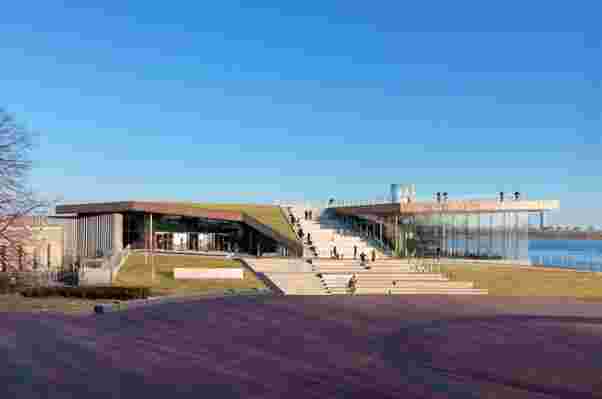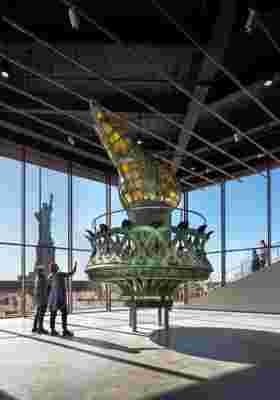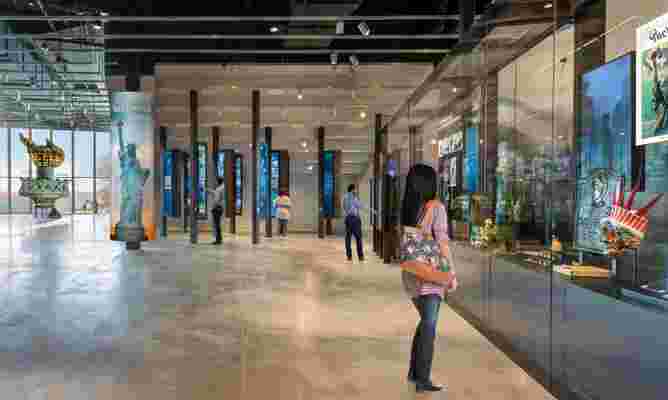On a recent foggy morning on New York’s Liberty Island, ferry horns bellowed over the sounds of construction. A team was making final touches to the Statue of Liberty Museum, the hotly anticipated addition to the storied site in New York Harbor that opens this Thursday.
More than five years in the making—and funded by a $100 million capital campaign—the museum is the largest addition to the nearly 15-acre site since its eponymous monument arrived stateside in 1886. The 26,000-square-foot space was designed by architects FXCollaborative with exhibition design by ESI Design. Inside, visitors can view an immersive film on the origins of the statue, see an exhibition on its history, and participate in an interactive component. The museum’s centerpiece is the monumental star—the statue’s original torch—which is surrounded by floor-to-ceiling windows offering views of Lady Liberty in the background.

The exterior of the building is clad in copper, which will oxidize over time to match the emerald-green of the Statue of Liberty.
Edwin Schlossberg, principal designer of ESI, explains that the design of the exhibition space is meant to keep visitors in motion. The first stop upon arriving is the immersive theater, which shows a three-part, ten-minute film narrated by Diane Sawyer. As each section of the film ends, visitors move clockwise into an adjoining theater room. The gently curved panorama screens and surround-sound speakers make the riveting tale of Lady Liberty especially impactful. “We did a very high-resolution sound system, so there is actually sound coming from the floor, the walls, and the ceiling, so it’s really surrounding you,” Schlossberg explains. Of the curvature of each theater, Schlossberg adds, “it was actually modeled on the flow of the statue’s robe.”

The original torch from the Statue of Liberty (which was replaced in the mid-1980s) will be on view for crowds visiting the museum.
Though past trips to Liberty Island often included long lines to enter a small museum inside the statue’s pedestal, the new structure is devised appropriately for the island’s large influx of visitors. Around 500 people arrive by ferry every 20 minutes, and the Liberty Museum is designed to accommodate all of them. (In contrast, the old museum could only allow entry to 4,000 people per day.) Nicholas Garrison, partner and design director at FXCollaborative, explains that this was a challenge. “If we took 500 people every 20 minutes and imagined a museum that would accommodate them, it would be bigger than this island,” he says. “So this building is really sized because of budgetary constraints and limits of land, but beyond that it’s about getting people in and out in a nice way.” That includes a door out of the torch gallery and an additional entry and exit point for crowded days—such flow is possible since there is no admission or ticket to the Liberty Museum. A rooftop terrace accessible by stairs and elevator also expands surface area without an additional footprint.

Visitors will have an interactive experience with the history of the Statue of Liberty inside of the museum.
Sustainability was also emphasized in the architectural design. A rooftop garden is planted with flowers and grasses that encourage native birds to make homes. And the museum’s windows are etched with lines of textured circles designed to prevent birds from flying into them. In the 10 months the glass has been up, “we haven’t had a bird strike,” Garrison says. The climate was also a consideration, namely protection from hurricanes. The back of the building features slots to accommodate storm surge—because there is nothing under the building, flooding water can rise and flow out without damaging the artifacts inside. And wind-resistant glass and a precast concrete exterior provide maximum insulation. Plus, rain gardens and a stone roof clean rainwater as it falls before getting released into the environment.
The rooftop of the museum is not only eco-friendly but also provides uninhibited views of the Statue of Liberty and New York City’s skyline.
Design aside, the team hopes this space pays respect to a site that’s meaningful to many. “It’s magical to be on this island, I think,” Garrison says. “The former superintendent was telling me a story, when we started this, that he still witnesses people coming to the island and getting on their hands and knees and kissing the ground,” says Garrison. Regardless of one’s leanings, the tale of Liberty—her journey to New York from France, and what her legacy continues to mean—is more than an American story. And during fraught times around issues of human rights and immigration, the island holds a certain poignancy. Turning the site into a setting for another architectural marvel would be beside the point. Garrison adds, “It’s just really important that we revere this place.”
